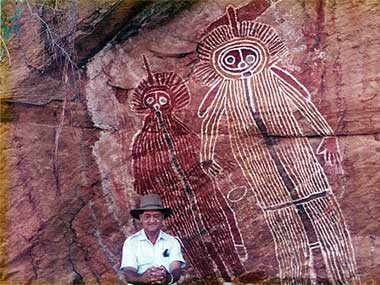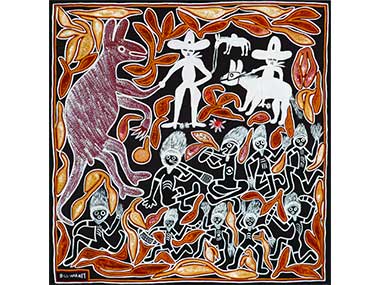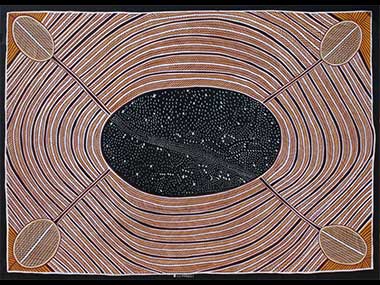BILL HARNEY

Artist and Cultural Icon, Bill Harney at the Wardaman rock-art site of the Lightening Brothers
Posted by Jeremy Eccles | 06.05.16
Dates:
06.05.16
: 16.07.16
Location: Godinymayin Yijard Rivers Arts & Culture Centre, Katherine, NT
A new exhibition opens today in the NT bringing to life a culture passing out of memory and one man’s remarkable journey to share the remaining vestiges of his Wardaman people with the world.
'Yidumduma Bill Harney: Bush Professor' is an exhibition celebrating the life work of Yidumduma Bill Harney. Held in his local community of Katherine, the exhibition will be open to the public until 16 July 2016 at the Godinymayin Yijard Rivers Arts & Culture Centre. It is then hoped it can travel.
At over 80 years of age, Bill Harney Jnr – his father was the white man who became NT Protector of Aborigines and an author, Bill Harney Snr - is one of the last fully initiated elders of the Wardaman people. He is a charismatic storyteller and artist and the only remaining living custodian of the collective memory, laws and history of his mother and step-father's people. “Yidumduma Bill Harney is also recognised throughout the world as an artist of high esteem on many different stages,” said Paul Taylor, who's work in preserving and recording Harney's extraordinary Indigenous knowledge through the Yubulyawan Dreaming Project includes the recording of 40 sacred rock art sites and over 150 hours of film.
“He is a master painter, storyteller, songman, Didgeridoo player/maker and author,” Taylor explained. “All his art forms have the deepest roots in the celebration of his Wardaman Aboriginal heritage and his unique ability to 'walk in both worlds' and communicate the joy of his culture to a global audience”.
As a result of this ethnographic priority, Harney's work does not appear in most institutional art collections apart from the Museum & Art Gallery of the NT, and, despite being a finalist eleven times, has never been selected as an award winner in the NATSIAAs. The only mention I could find of Bill is in the McCulloch Aboriginal Art encyclopedia, which acknowledges the link between his canvases and rock art images of the Lightning Men/Initiates.
So I turned to the Godinymayin exhibition's curator, Margie West AM – long-time MAGNT curator and friend of Harney's. She began by explaining how this Wardaman elder had had a white father. “His father was in the NT working with donkeys and connected with his mother, who conceived Bill. Later he became a Patrol Officer and then Protector; and in both positions it was illegal with 'fraternise with the natives'. So, publicly, he denied paternity”, and there's no reference to it in his books such as 'Taboo', where the anthropologist AP Elkin ironically acknowledges Bill Snr as “one of those extremely rare persons – a man who had lived in close contact with Aborigines and really did have some real knowledge of their life – their mind and fundamental beliefs”.
“Despite this”, West continued, “old Bill did keep in touch with the family. Bill's mother then took a Wardaman husband and young Bill was adopted – though she had to black up his face with bush plum when the Welfare was around”.
As a child, Harney learned the ways of the Wardaman people from his mother and stepfather and also the stories connected to the stunning ancient rock art seen on the land of his people, including the famous Lightning Brothers site, with its apparent links to Wandjina images in The Kimberley. Harney’s knowledge has been described by anthropologists as 'encyclopedic in nature’, and his artwork – encouraged by the rock art expert, George Chaloupka in the late 1980s - is one way that he shares this intimate understanding with the world. “We were taken to sites with rock art in them when I was young, then again when I was learning, in the initiation years”.
His first show was in 1990 at MAGNT, based upon the headboards used in ceremonial dancing – like Rover Thomas's early Goorirr Goorirr (as his Krill Krill ceremony is now written) works. “Later”, recalls West, “he did a superb 4.3-metre work for the NATSIAAs that was part of a successful Land Claim. And now at 80 plus he lives on his two land rights, farming”. Bill relishes this reversal of fortune: “Today, we’re back on the cattle station, the country I grew up in! … great big family at Menngen, dozen houses, fifty more people, sharing what we need – like the old station days”.
Margie West offers some perspective: “This was massacre country, and the pastoralists kicked the Wardaman off their own lands as soon as equal pay came in, despite all those years of free labour. That lead to a 20-year hiatus around Katherine and the alcohol that came with their new Referendum rights. Both those 'advances' had their good and bad points! But they certainly lead to a loss of culture and initiated elders amongst the Wardaman”. Bill Harney found his way back to self-respect by leading cultural tours to the Wardaman rock art sites from 1988 until today. There's one associated with the exhibition opening.
In his art, Bill takes a more positive view of the past than can be seen recorded on the cave walls. Here's his description of the illustrated work, 'Wangga' (2009): “When the people singing and dancing with the didgeridoo and clapstick, they were showing skill and tricks they could do. Then the first white men arrive with the horse. Saw the kangaroo standing up. That kangaroo welcome him and say that white man can stay in Australia. Then they shook hands together. Old roo said ’We stay on in peace together …’ The white men rode away and left them in peace. That’s the Wanggar story in my country, Wardaman country. It’s in the rock paintings too, in my country, still today”.
But in the original cave work seen in the exhibition's catalogue, there are quite clearly guns in white hands – that 'peace' was illusory. “Bill's very positive about black and white relations”, explained Margie West, “he's a forward-looker. But his art is mostly backward-looking – subjects such as the heavens, where his huge knowledge lead to the book, 'Dark Sparklers' with Hugh Cairns, the law, bush foods and the Wardaman creation and their progenitors”. There are 20 canvases and a number of sculptures in the show.
Bill Harney himself explains: “The Lawman training often took place at the most important sites, so that’s why I remember the images so well. We were painting ourselves up, fixing the feather decorations, singing the song. We were sleeping among them places, dreaming the stories, finding Spirituals travelling in the stars. That’ s how I paint, they’re in my mind all the time, I see them! So I can paint the Law! We can justify everything you know, what we can see in front of us: bush medicine, rock formations and all that. Your professor is reading that in a book. We’re bush professors. We all got it from a song and a story from the creation and it’s still there today, and we’re passing that information to the young ones from word-of-mouth”.
Share this:
»  del.icio.us
»
del.icio.us
»  Digg it
»
Digg it
»  reddit
»
reddit
»  Google
»
Google
»  StumbleUpon
»
StumbleUpon
»  Technorati
»
Technorati
»  Facebook
Facebook
Contact Details

'Wangga' (2009) by Yidumduma Bill Harney, synthetic polymer paint on canvas, courtesy GYR Arts & Culture Centre - a painting taken almost stright off the cave wall

Bill Harney's 'Wume - The Night Sky' (2002) a painting from his book, 'Dark Sparklers'
Further Research
Artists: Rover Thomas | Yidumduma Bill Harney
News Tags: Bill Harney Jnr | Bill Harney Snr | Godinymayin Yijard Rivers Arts & Culture Centre | Jeremy Eccles | Lightning Brothers | Margie West | Wardaman
News Categories: Australia | Blog | Exhibition | Feature | Industry | News
Exhibition Archive
- 10.10.17 | TARNANTHI 2017
- 11.08.17 | Natsiaas 2017
- 20.07.17 | APY ART DOMINATES THE WYNNE
- 17.07.17 | Anangu Artist Wins $100,000 Prize
- 14.07.17 | The End of AAMU
- 11.07.17 | ART ACROSS THE COUNTRY
- 11.07.17 | TARNANTHI IN OCTOBER
- 05.07.17 | TJUNGUṈUTJA - from having come together
- 13.06.17 | Ghost-Nets Straddle the World
- 07.06.17 | Grayson Perry Going Indigenous?
- 05.06.17 | Barks Bigger than Ben Hur
- 27.05.17 | NGA QUINQUENNIAL 2017
- 21.05.17 | Blak Douglas Finds Home at the NGA
- 21.05.17 | BRIAN ROBINSON WINS HAZELHURST WOP
- 18.05.17 | PARRTJIMA 2.0
Advertising

